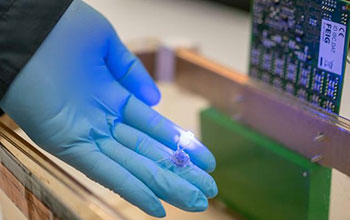Device stimulates the endings of nerve responsible for the regulation of food intake

The paddle-shaped device consists of a harvester containing microchips for wireless communication.
Gastric bypass surgery is sometimes the last resort for those who struggle with obesity or serious weight-related health issues. Since this procedure involves making a small stomach pouch and rerouting the digestive tract, it is invasive and prolongs the recovery period for patients.
In a U.S. National Science Foundation-supported study, researchers at Texas A&M University have developed a medical device that might help with weight loss while requiring a simpler operative procedure for implantation.
The scientists said their centimeter-sized device provides the feeling of fullness by stimulating the endings of the vagus nerve with light. Unlike other devices that require a power cord, their device is wireless and can be controlled externally from a remote radio frequency source.
"We wanted to create a device that not only requires minimal surgery for implantation but also allows us to stimulate specific nerve endings in the stomach," said Sung II Park, an electrical and computer engineer. "Our device has the potential to do both these things in harsh gastric conditions, which, in the future, can be hugely beneficial to people needing weight loss surgeries."






